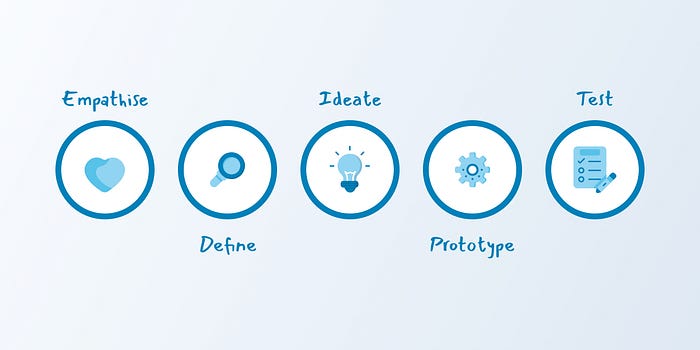Create rapid solutions for problems within five different phases

Design Thinking: create rapid solutions with multidisciplinary teams
Design Thinking is an iterative and non-linear solution-based process of solving problems. It was introduced by Nobel Prize laureate Herbert Simon in The Sciences of the Artificial in 1969. Since then, some of the world’s leading brands, such as Google, Apple, and Samsung, have adopted the framework for innovating solutions to meet specific user needs.
Design Thinking contains several phases which can be used in any order:
- Empathise. Observe and develop an understanding of your target user’s needs and problems.
- Define. Use insights from empathy to create problem statements to be solved.
- Ideate. Challenge assumptions and create innovative solutions to solve the problem.
- Prototype. Build flat or functioning designs to bring solutions to life.
- Test. Validate ideas by testing them with real users.
The Design Thinking phases can be viewed as an overview of principles that contribute to an innovative project and shouldn’t be necessarily sequential. You may visit any of the phases at any time: for example, iterate your prototype based on feedback from testing.

- Understand: In order to solve a problem, you need to understand it first. This beginning stage in the Design Thinking Process is all about taking the initial steps towards understanding the problem at hand. You’ll create problem statements and perform competitor analyses to ensure you understand not only what you’ll create but the landscape you’ll be creating it in, as well.
- Observe: In this second stage of the Design Thinking Process, you’ll be performing user research in order to observe your potential users and determine their needs and goals. User interviews and surveys fall under this stage.
- PoV: At this stage, your goal is to step into the shoes of your users and “see” your product from their point of view using design personas. The closer we can get to our users, the greater our chance of fulfilling their needs efficiently.
- Ideate: Now that you’ve collected all these observations, it’s time to make ideas out of them. This is the part of the creative process that allows you to explore a wide variety and large quantity of diverse possible solutions. The purpose of ideation is to move beyond the obvious in order to explore a full range of ideas. User flows, sketching, wireframes, and card sorting all fall under this category.
- Prototype: This is the experimental stage of the process. Transform your ideas into a physical and interactive format so that they can be experienced by others.
- Test: In this stage, you’ll be testing your prototypes with real users and stakeholders, collecting feedback, then improving and iterating on your designs again and again. Validating your designs in the early stages is a great way to solve problems before they become unmanageable. Use observations and feedback from people to create new hypotheses and build empathy with your users.
- Tell Story: As designers, we oftentimes must justify our design solutions to colleagues, managers, and stakeholders. This step is all about explaining and defending design decisions via effective storytelling while still being open to critique and feedback.


